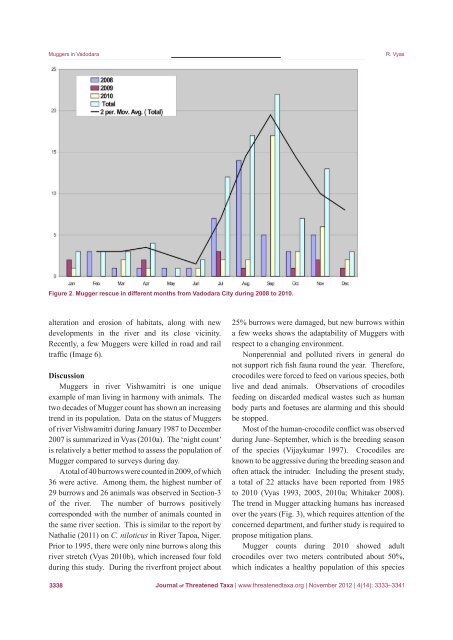View - Journal of Threatened Taxa
View - Journal of Threatened Taxa
View - Journal of Threatened Taxa
Create successful ePaper yourself
Turn your PDF publications into a flip-book with our unique Google optimized e-Paper software.
Muggers in VadodaraR. VyasFigure 2. Mugger rescue in different months from Vadodara City during 2008 to 2010.alteration and erosion <strong>of</strong> habitats, along with newdevelopments in the river and its close vicinity.Recently, a few Muggers were killed in road and railtraffic (Image 6).DiscussionMuggers in river Vishwamitri is one uniqueexample <strong>of</strong> man living in harmony with animals. Thetwo decades <strong>of</strong> Mugger count has shown an increasingtrend in its population. Data on the status <strong>of</strong> Muggers<strong>of</strong> river Vishwamitri during January 1987 to December2007 is summarized in Vyas (2010a). The ‘night count’is relatively a better method to assess the population <strong>of</strong>Mugger compared to surveys during day.A total <strong>of</strong> 40 burrows were counted in 2009, <strong>of</strong> which36 were active. Among them, the highest number <strong>of</strong>29 burrows and 26 animals was observed in Section-3<strong>of</strong> the river. The number <strong>of</strong> burrows positivelycorresponded with the number <strong>of</strong> animals counted inthe same river section. This is similar to the report byNathalie (2011) on C. niloticus in River Tapoa, Niger.Prior to 1995, there were only nine burrows along thisriver stretch (Vyas 2010b), which increased four foldduring this study. During the riverfront project about25% burrows were damaged, but new burrows withina few weeks shows the adaptability <strong>of</strong> Muggers withrespect to a changing environment.Nonperennial and polluted rivers in general donot support rich fish fauna round the year. Therefore,crocodiles were forced to feed on various species, bothlive and dead animals. Observations <strong>of</strong> crocodilesfeeding on discarded medical wastes such as humanbody parts and foetuses are alarming and this shouldbe stopped.Most <strong>of</strong> the human-crocodile conflict was observedduring June–September, which is the breeding season<strong>of</strong> the species (Vijaykumar 1997). Crocodiles areknown to be aggressive during the breeding season and<strong>of</strong>ten attack the intruder. Including the present study,a total <strong>of</strong> 22 attacks have been reported from 1985to 2010 (Vyas 1993, 2005, 2010a; Whitaker 2008).The trend in Mugger attacking humans has increasedover the years (Fig. 3), which requires attention <strong>of</strong> theconcerned department, and further study is required topropose mitigation plans.Mugger counts during 2010 showed adultcrocodiles over two meters contributed about 50%,which indicates a healthy population <strong>of</strong> this species3338<strong>Journal</strong> <strong>of</strong> <strong>Threatened</strong> <strong>Taxa</strong> | www.threatenedtaxa.org | November 2012 | 4(14): 3333–3341

















